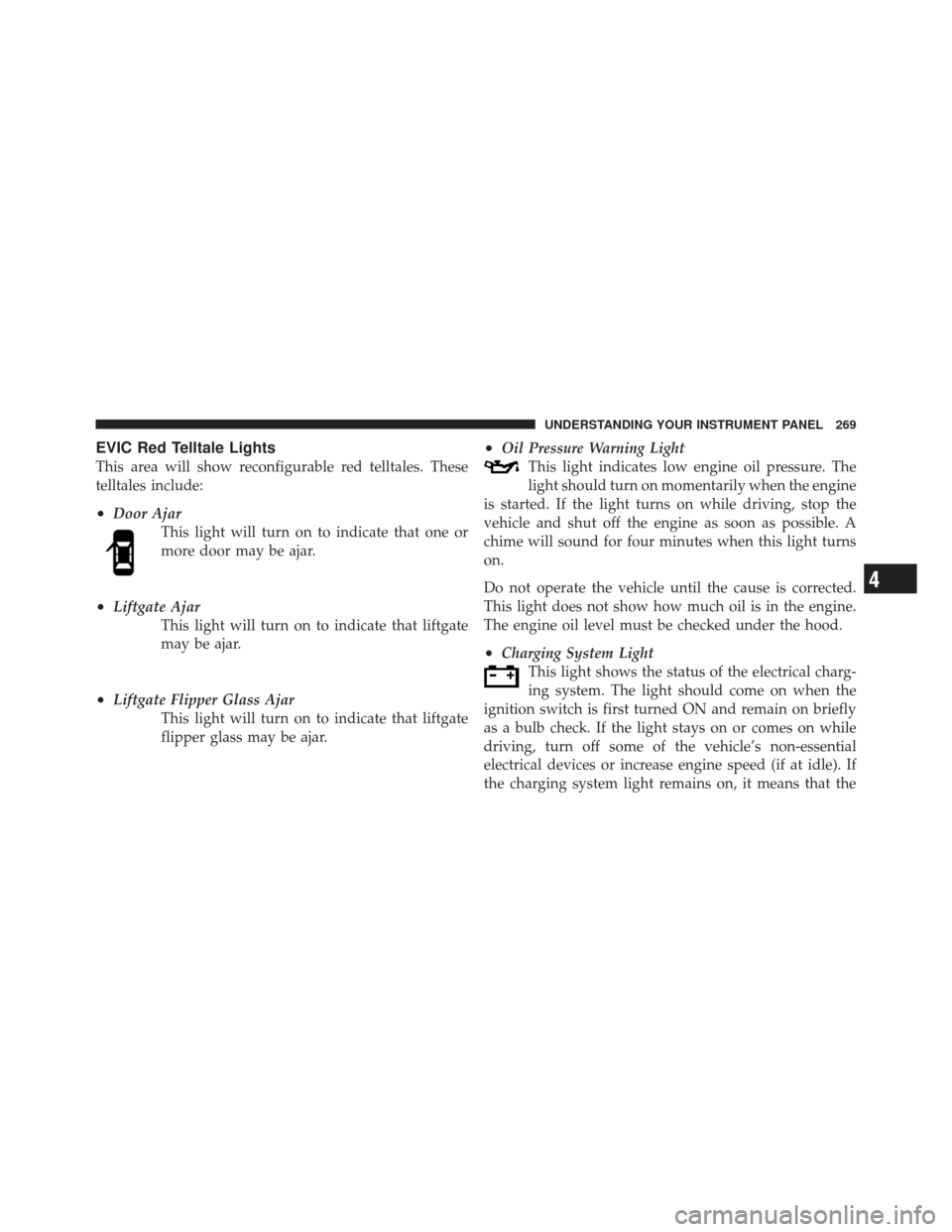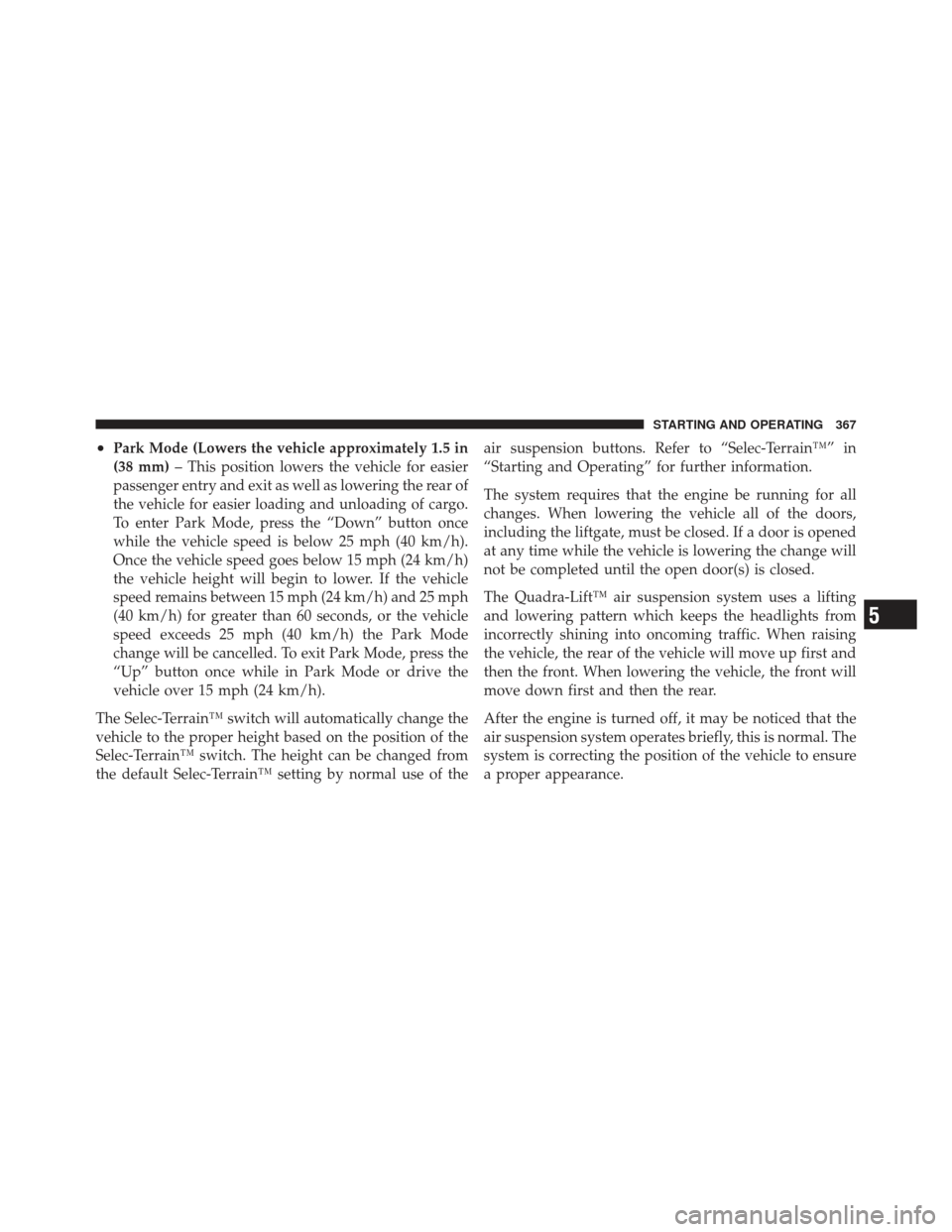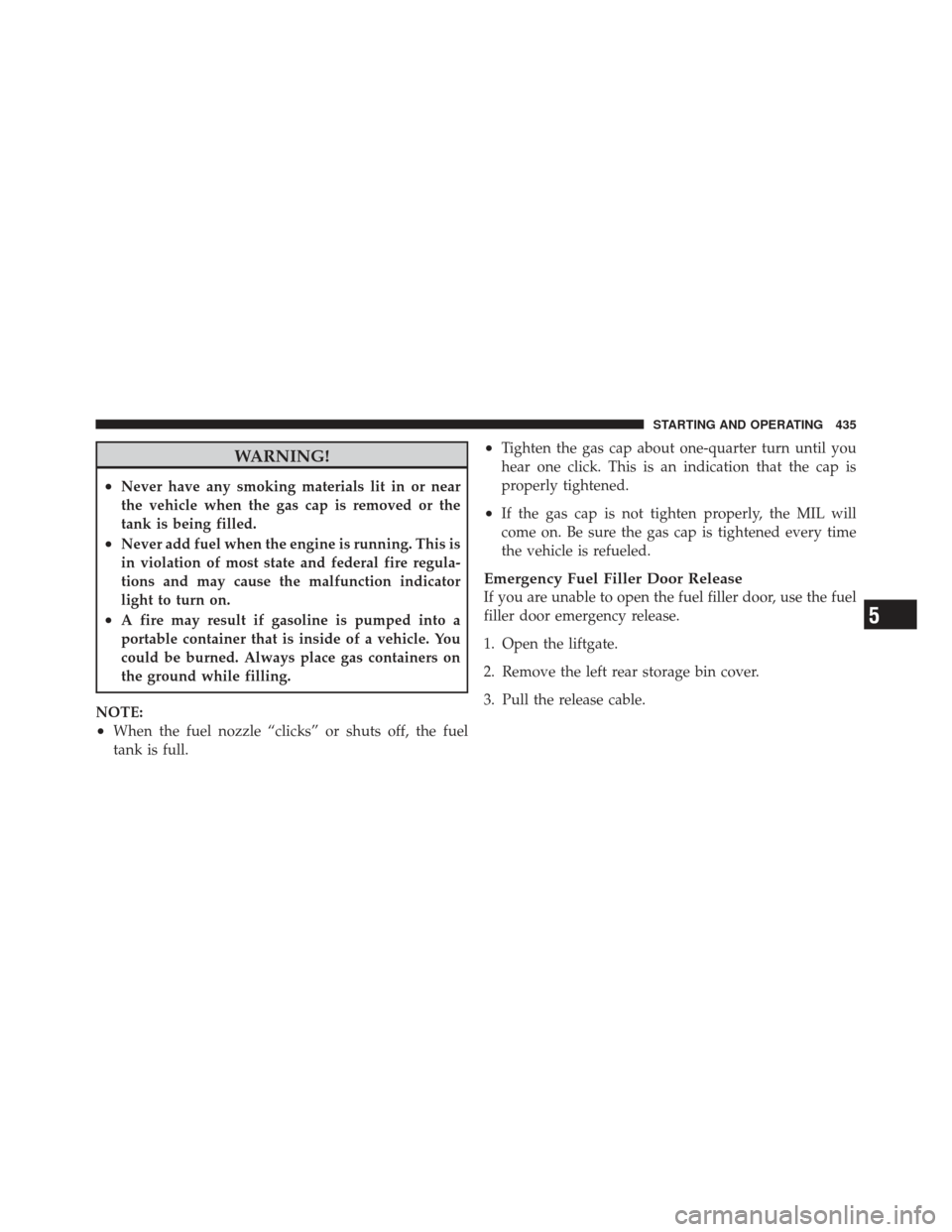Page 265 of 587
•Remote start disabled — System fault
•Remote start disabled — Turn key
•Remote start active — Key to Run
•Memory 1 profile set
•Memory 2 profile set
•Memory system unavailable — Not in Park
•Memory system unavailable — Seatbelt buckled
•Memory 1 profile recall
•Memory 2 profile recall
•Press Brake Pedal and Push Button to Start
•Wrong Key
•Damaged Key
•Key not programmed
•Function currently unavailable — Power Liftgate
•Unlock to operate — Power Liftgate
•Put in Park to operate — Power Liftgate
•Automatic high beams on
•Automatic high beams off
•Service Four Wheel Drive System
•Four Wheel Drive System in neutral
•ECO — Fuel Saver Indicator
•TERRAIN SETTINGS — AUTOMATIC
•TERRAIN SETTINGS — ROCK
•TERRAIN SETTINGS — SAND/MUD
•TERRAIN SETTINGS — SNOW
•TERRAIN SETTINGS — SPORT
4
UNDERSTANDING YOUR INSTRUMENT PANEL 263
Page 267 of 587

•Service Air Suspension System — This is displayed
when a fault has occurred in the system. The system
will have limited operation at that point.
•Immediate Air Suspension Service/Repair Required
— This is displayed when a fault has occurred in the
system which results in a complete system shutdown.
The system will be non operational at that point.
•Reduce Speed To Maintain Selected Ride Height —
This message is displayed in advance warning to the
driver that the vehicle will be moved to the next lower
preset position unless the speed is reduced.
•Selected Ride Height Not Permitted — The vehicle
speed is too high to enter one of the preset levels
(Entry/Exit Level/Off Road Ride Height Level 1/Off
Road Ride Height Level 2).
•Air Suspension System Cooling Down – Please Wait —
This message is displayed if the compressor tempera-
ture level is too high. Level control is suspended until
the compressor has cooled down.
•Vehicle Cannot Be Lowered – Door Open — This
message is displayed if a door or the liftgate is ajar and
level control is suspended.
•Air Suspension Temporarily Disabled For Jacking And
Tire Change
•Aerodynamic Ride Height — This is displayed (for
5 seconds) when the vehicle has achieved the Aerody-
namic Height.
4
UNDERSTANDING YOUR INSTRUMENT PANEL 265
Page 271 of 587

EVIC Red Telltale Lights
This area will show reconfigurable red telltales. These
telltales include:
•Door AjarThis light will turn on to indicate that one or
more door may be ajar.
•Liftgate AjarThis light will turn on to indicate that liftgate
may be ajar.
•Liftgate Flipper Glass AjarThis light will turn on to indicate that liftgate
flipper glass may be ajar.
•Oil Pressure Warning LightThis light indicates low engine oil pressure. The
light should turn on momentarily when the engine
is started. If the light turns on while driving, stop the
vehicle and shut off the engine as soon as possible. A
chime will sound for four minutes when this light turns
on.
Do not operate the vehicle until the cause is corrected.
This light does not show how much oil is in the engine.
The engine oil level must be checked under the hood.
•Charging System Light This light shows the status of the electrical charg-
ing system. The light should come on when the
ignition switch is first turned ON and remain on briefly
as a bulb check. If the light stays on or comes on while
driving, turn off some of the vehicle’s non-essential
electrical devices or increase engine speed (if at idle). If
the charging system light remains on, it means that the
4
UNDERSTANDING YOUR INSTRUMENT PANEL 269
Page 369 of 587

•Park Mode (Lowers the vehicle approximately 1.5 in
(38 mm)– This position lowers the vehicle for easier
passenger entry and exit as well as lowering the rear of
the vehicle for easier loading and unloading of cargo.
To enter Park Mode, press the “Down” button once
while the vehicle speed is below 25 mph (40 km/h).
Once the vehicle speed goes below 15 mph (24 km/h)
the vehicle height will begin to lower. If the vehicle
speed remains between 15 mph (24 km/h) and 25 mph
(40 km/h) for greater than 60 seconds, or the vehicle
speed exceeds 25 mph (40 km/h) the Park Mode
change will be cancelled. To exit Park Mode, press the
“Up” button once while in Park Mode or drive the
vehicle over 15 mph (24 km/h).
The Selec-Terrain™ switch will automatically change the
vehicle to the proper height based on the position of the
Selec-Terrain™ switch. The height can be changed from
the default Selec-Terrain™ setting by normal use of the air suspension buttons. Refer to “Selec-Terrain™” in
“Starting and Operating” for further information.
The system requires that the engine be running for all
changes. When lowering the vehicle all of the doors,
including the liftgate, must be closed. If a door is opened
at any time while the vehicle is lowering the change will
not be completed until the open door(s) is closed.
The Quadra-Lift™ air suspension system uses a lifting
and lowering pattern which keeps the headlights from
incorrectly shining into oncoming traffic. When raising
the vehicle, the rear of the vehicle will move up first and
then the front. When lowering the vehicle, the front will
move down first and then the rear.
After the engine is turned off, it may be noticed that the
air suspension system operates briefly, this is normal. The
system is correcting the position of the vehicle to ensure
a proper appearance.
5
STARTING AND OPERATING 367
Page 431 of 587
WARNING! (Continued)
•Guard against carbon monoxide with proper
maintenance. Have the exhaust system inspected
every time the vehicle is raised. Have any abnor-
mal conditions repaired promptly. Until repaired,
drive with all side windows fully open.
•Keep the liftgate closed when driving your vehicle
to prevent carbon monoxide and other poisonous
exhaust gases from entering the vehicle.
FLEXIBLE FUEL (3.6L ENGINE ONLY) —
IF EQUIPPED
E-85 General Information
The information in this section is for Flexible Fuel ve-
hicles only. These vehicles can be identified by a unique
fuel filler door label that statesEthanol (E-85) or Un-
leaded Gasoline Only. This section only covers those
subjects that are unique to these vehicles. Please refer to the other sections of this manual for information on
features that are common between Flexible Fuel and
gasoline-only powered vehicles.E-85 Fuel Cap
5
STARTING AND OPERATING 429
Page 437 of 587

WARNING!
•Never have any smoking materials lit in or near
the vehicle when the gas cap is removed or the
tank is being filled.
•Never add fuel when the engine is running. This is
in violation of most state and federal fire regula-
tions and may cause the malfunction indicator
light to turn on.
•A fire may result if gasoline is pumped into a
portable container that is inside of a vehicle. You
could be burned. Always place gas containers on
the ground while filling.
NOTE:
•When the fuel nozzle “clicks” or shuts off, the fuel
tank is full.
•Tighten the gas cap about one-quarter turn until you
hear one click. This is an indication that the cap is
properly tightened.
•If the gas cap is not tighten properly, the MIL will
come on. Be sure the gas cap is tightened every time
the vehicle is refueled.
Emergency Fuel Filler Door Release
If you are unable to open the fuel filler door, use the fuel
filler door emergency release.
1. Open the liftgate.
2. Remove the left rear storage bin cover.
3. Pull the release cable.
5
STARTING AND OPERATING 435
Page 484 of 587

▫Brake System ....................... 507
▫ Front/Rear Axle Fluid ................. 509
▫ Transfer Case ....................... 510
▫ Automatic Transmission ............... 511
▫ Appearance Care And Protection From
Corrosion .......................... 515
� Fuses .............................. 520
▫ Totally Integrated Power Module ......... 520
� Vehicle Storage ....................... 525
� Replacement Bulbs .................... 526
� Bulb Replacement ..................... 527
▫ High Intensity Discharge Headlamps (HID) –
If Equipped ........................ 527 ▫
Halogen Headlamps – If Equipped ........ 527
▫ Front Turn Signal .................... 528
▫ Front Fog Lamps .................... 528
▫ Rear Tail, Stop, Turn Signal, And Backup
Lamps ............................ 530
▫ Rear Liftgate Mounted Tail Lamp ......... 531
▫ Center High-Mounted Stop Lamp
(CHMSL) .......................... 532
▫ Rear License Lamp ................... 532
� Fluid Capacities ...................... 533
� Fluids, Lubricants, And Genuine Parts ....... 534
▫ Engine ............................ 534
▫ Chassis ........................... 535
482 MAINTAINING YOUR VEHICLE
Page 498 of 587

Refrigerant Recovery and Recycling
R-134a Air Conditioning Refrigerant is a hydrofluoro-
carbon (HFC) that is endorsed by the Environmental
Protection Agency (EPA) and is an ozone-saving product.
However, the manufacturer recommends that air condi-
tioning service be performed by authorized dealers or
other service facilities using recovery and recycling
equipment.
Body Lubrication
Locks and all body pivot points, including such items as
seat tracks, door hinge pivot points and rollers, liftgate,
tailgate, sliding doors and hood hinges, should be lubri-
cated periodically with a lithium based grease, such as
MOPAR�Spray White Lube or equivalent to assure
quiet, easy operation and to protect against rust and
wear. Prior to the application of any lubricant, the parts
concerned should be wiped clean to remove dust and
grit; after lubricating excess oil and grease should be
removed. Particular attention should also be given to hood latching components to ensure proper function.
When performing other underhood services, the hood
latch, release mechanism and safety catch should be
cleaned and lubricated.
The external lock cylinders should be lubricated twice a
year, preferably in the Fall and Spring. Apply a small
amount of a high quality lubricant, such as MOPAR�
Lock Cylinder Lubricant or equivalent directly into the
lock cylinder.Windshield Wiper Blades
Clean the rubber edges of the wiper blades and the
windshield periodically with a sponge or soft cloth and a
mild nonabrasive cleaner to remove accumulations of salt
or road film.
Operation of the wipers on dry glass for long periods
may cause deterioration of the wiper blades. Always use
washer fluid when using the wipers to remove salt or dirt
from a dry windshield.
496 MAINTAINING YOUR VEHICLE